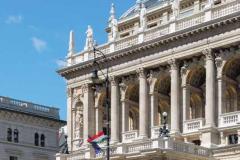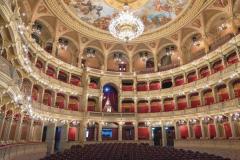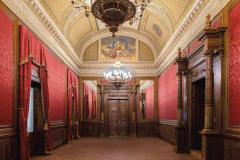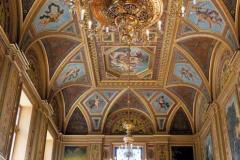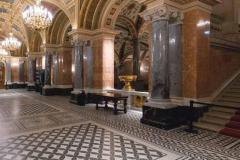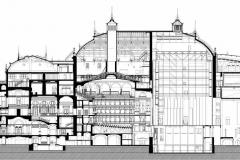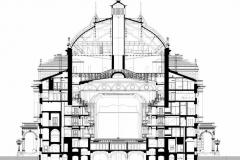Retuning
The Reconstruction of the Opera House
Architect: Gábor Zoboki
Text: Bálint Botzheim
Photos: Tamás Réthey-Prikkel
The Opera House of Budapest was accepted with huge respect on its opening to the public in 1884. Built after designs by Miklós Ybl, it was an architectural bravado of architecture and is regarded as such even today. The original programme of this recent reconstruction project was about a partial modernization, but as a result of research work and proposals by restorers and designers the government made a decision to comprehensively reconstruct it in 2018. During this project the architectural values outlined by Ybl were restored. As a result, the Opera House now welcomes visitors who can take a tour in the era of the Monarchy. The entire facade has been restored to its former glory, including the decorative lighting of both the facade and the roof. The grand staircase received a new two-tier chandelier, the original palette of the oakwood wainscot in the Red Parlour was restored to its original. The scene painters’ workshops were moved to the Eiffel Hall thus freeing two large halls that can be used now for rehearsals. The basement also contains rooms made free now to be used as previously missing changing rooms by members of the orchestra. The house is also reborn regarding acoustics. The orchestra pit was also restored to its original dimensions, the floor of the auditorium has also been converted to integrate the original but more massive timber framework. In front of the stage the so-called wooden curtain was rebuilt to frame the proscenium with a significant role in acoustics.
The seating capacity of the auditorium was reduced to 1,000 people as a result of the remodelling, whilst on the 3rd floor standing lots have been created with back support. Tickets to these offer a unique experience of music: sound waves returning from the auditorium and those guided outward by the conical surface of the ceiling fresco condense right here. As a result of the renovation, besides the authentic reconstruction of the historic structures, the operation of the building was elevated to such a technical level which can serve one of the most significant institutions of Hungarian culture in a modern contemporary way.
Client: Hungarian State Opera
Project management: CÉH Ltd.
General architecture: ZDA Zoboki Architects
Leading architect: Gábor Zoboki
Project architects: Richárd Borzák, Zoltán Turi
Project coordinator: Dóra Farkas
Architects: András Antmann Somogyi, Máté Molnár, Valéria Árvainé Szabó, Zoé Molnár, Dávid Bánsági, Balázs Orlovits, Judit Besey, Ildikó Palásti, Fatime Csöndes-Albert, Mónika Poller, Attila Fekete, Béla Reppert, Ferenc Fekete, Virág Révai, Bonifác Galgóczki, Pál Rutkai, Réka Iványi, Krisztián Seidl, Anna Jaczó, Csaba Silvester, Gábor Kacsoh, Balázs Szlabey, László Kakas, Júlia Dominika Szontág, Anna Kormányos, Gerda Sztankó, Albert Lencsés, András Tímár, Bernadett Miklós
Fellow architect: Balázs Zimay– ZED Architect Studio
Interior design: Kálmán Czakó – Czakó Ltd, Mónika Simon, Lívia Haraszti,
Dóra Kalász, Patrícia Pálmai-Juhász, Marianna Fehér– Stúdió Kvarc Ltd.; Nóra Demeter, Edina Simon – Demeter Design Studio
Facade survey: Zoltán Deák– Tripartitum Ltd.
Structure: Balázs Takács – FRT Raszter Ltd.
Framework: Gábor Bimbó– STR Design Ltd., Ferenc Kamarás – Kamarások Ltd., Péter Rabb – 2 RABB Ltd.
HVAC: János Áy, Norbert Szakál, Attila Szendi– Körös Consult Ltd.
Electrical engineering: Ferenc Rajkai– Hungaroproject Engineering
Landscape: Zoltán Nemes – Vár-Kert Ltd., Bálint Koszorú – Város-Teampannon
Kitchen technology: Alexandra Rétfalvi Kurucz – Design Studio
Fire protection: György Báder – Pro Almond Ltd.
Acoustics of the Auditorium: Federico Cruz-Barney – STUDIO DAP, Csaba Huszty– Entel Ltd.
Building acoustics: Éva Borsiné Arató – Arató Ltd., Gusztáv Józsa
CAD: Ákos Mátételki – Greypixel Kft.
Restoration: András Seres, Alexandra Tóth, Éva Magyar, Lőrinc Tímár, Melinda Nagy, Bálint Rékasy, Péter Zágoni, Zsolt Kóbor, Gábor Ludányi, Zsuzsa Herling – Mentartis Ltd.
Monument expert: Tamás Mezős
Textile works: Eszter Fellegi, Eszter Révész
Art historian: Márta Branczik
Stage technology: Zsuzsa Tompai
Lights: Ferenc Haász – MadebyLight
Signals: Dávid Drozsnyik – Graphasel Ltd.
Accessibility: Henriett Szabó
Main contractor: W-É-L Opera Consortium

